Yves Saint Laurent
Spring/Summer 1988 Couture
Paul Cézanne
The Basket of Apples, 1893
What’s in a fruit? Certainly enough antioxidants to stimulate the creative juices of imaginative minds across all mediums. Truth be told, these edible, seed-bearing structures have not only acted as sources of sustenance for centuries, but have proven objects of esteemed inspiration for countless individuals. Historically, fashion designers, artists and architects alike have been transfixed by this wondrous food group, bestowing upon these edible objects artistic significance outside the realm of nourishment.
Yves Saint Laurent was one of the first couturieres to utilize fruit for its decorative capabilities, elevating these familiar objects into the domain of high fashion. For spring/summer 1988 couture, monsieur Saint Laurent decorated highly ornate, Lesage-embroidered dinner jackets with three-dimensional bejeweled grapes, oranges, apples and lemons. Following suit, for his spring/summer 2001 haute couture collection at the house of Christian Dior, creative director John Galliano covered couture gowns with child-like illustrations of strawberries, pears, cherries and bananas.
Yves Saint Laurent
Spring/Summer 1988 Couture
Yves Saint Laurent
Spring/Summer 1988 Couture
Christian Dior
Spring/Summer 2001 Couture
Christian Dior
Spring/Summer 2001 Couture
In the decade that followed, Stella McCartney employed a citrus motif depicting sliced lemons, limes, grapefruits and oranges as a focal point of her spring/summer 2011 ready-to-wear collection, while the following year, Italian design duo Dolce & Gabbana expressed their affinity for seedy goodness through garments doused in tomato prints, followed by lemons for spring 2016, and a tropical pineapple print for spring 2017; in that same season, American designer Joseph Altuzarra sent pineapple-covered dresses parading down his runway at New York fashion week, along with garments covered in lemons and cherries.
Stella McCartney
Spring/Summer 2011
Dolce & Gabbana
Spring/Summer 2012
Dolce & Gabbana
Spring/Summer 2016
Altuzarra
Spring/Summer 2017
Altuzarra
Spring/Summer 2017
While countless designers have toyed with the concept of satisfying shopper’s visual taste buds, the preeminent example on many minds of fruit motifs in fashion are those utilizing bananas. For spring/summer 2004, Phoebe Philo showcased a banana print on relaxed garments for Chloe, while for spring/summer 2011, Miuccia Prada presented a banana-pattern that has since become one of the Italian brand’s most iconic motifs; one of Prada’s foremost references that particular season was French dancer Josephine Baker in her trademark banana costume, a look that was later revived by model Pat Cleveland on the runway for Patrick Kelly in 1985.
Chloé
Spring/Summer 2004
Prada
Spring/Summer 2011
Prada
Spring/Summer 2011
Josephine Baker
Banana Costume
Pat Cleveland as Josephine Baker
Patrick Kelly Fashion Show, 1985
While bananas have proven a favorite subject for fashion designers, they have also garnered comparable attention within the context of art. Andy Warhol famously utilized the unique fruit on a paper shift dress he produced in 1966; Warhol then employed the same motif as the subject of his cover art for The Velvet Underground’s debut album in 1967. Similarly, artist Mike Kelley utilized Bananas as a vehicle to merge art and fashion in 1981, with his yellow ‘Banana Man’ costume, while American figurative painter Mel Ramos – famous for his works depicting nude or provocatively clad females – produced a sculpture in 2007 titled ‘Chiquita Banana’, of a naked woman emerging from a banana peel.
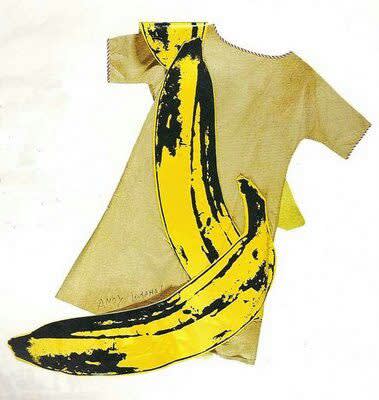
Andy Warhol
Banana dress, 1966
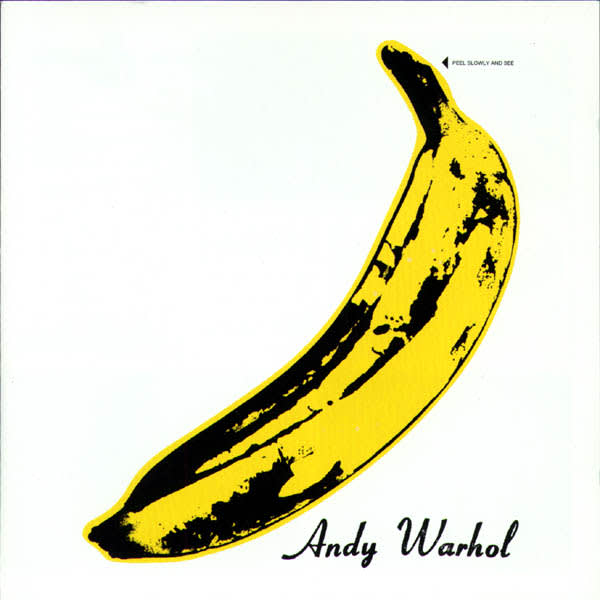
Andy Warhol
The Velvet Underground & Nico, 1967
Mike Kelley
Banana Man Costume, 1981
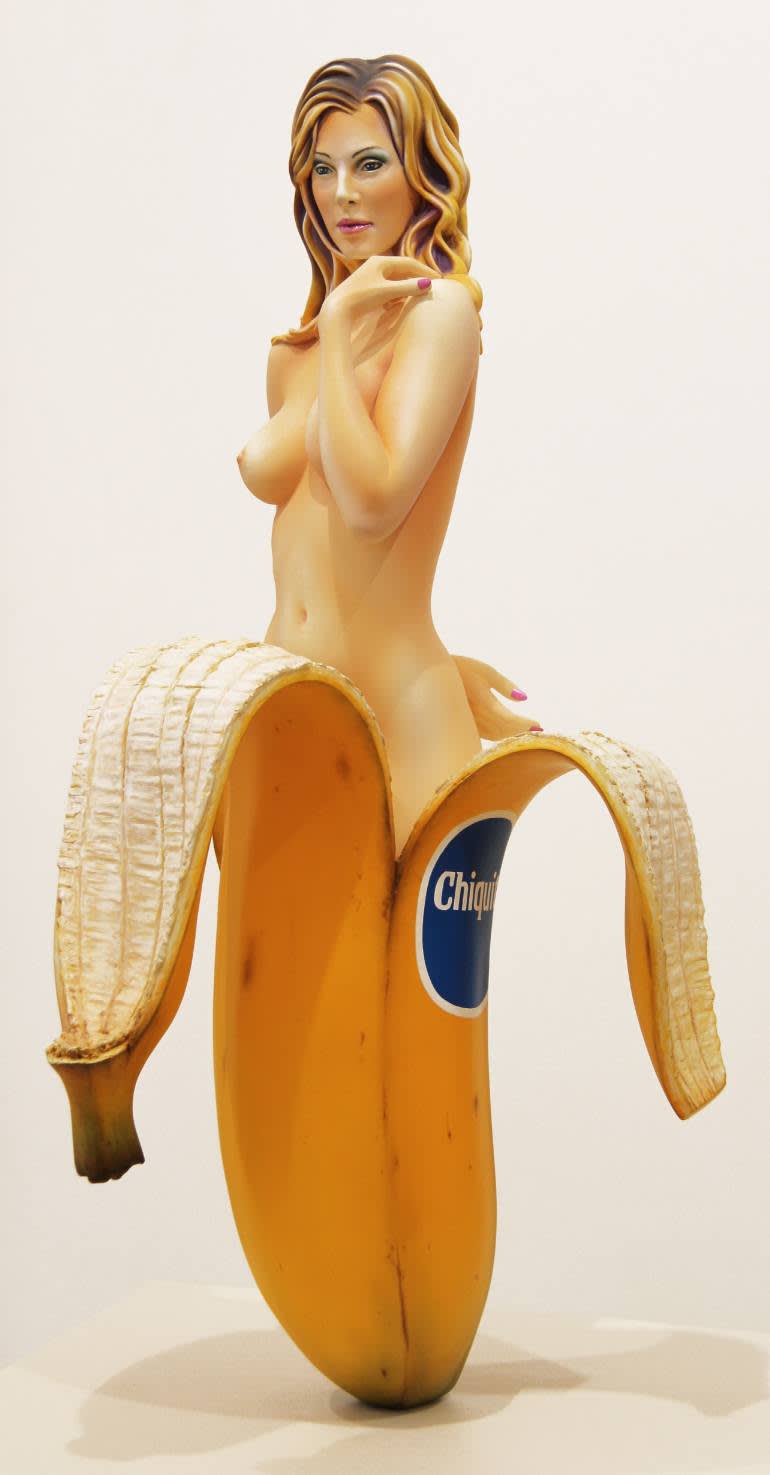
Mel Ramos
Chiquita Banana, 2007
One of the earliest examples of fruits in fine art, is in the work of Italian painter Giuseppe Arcimboldo; well known for his 16th century portraits of human heads made entirely of edible objects such as fruits, vegetables and fish. Most recently, Rei Kawakubo employed a number of Arcimboldo’s portraits as motifs covering exaggerated dresses in Comme des Garçons’s spring 2018 runway collection.
Giuseppe Arcimboldo
Vertumnus, a portrait depicting Rudolf II, 1590-1
Giuseppe Arcimboldo
Autumn, 1573
Comme des Garçons
Spring/Summer 2018
Comme des Garçons
Spring/Summer 2018
It is impossible to speak about the importance of fruit in the context of art history without discussing still lifes, a prominent genre of painting within the careers of countless artists, with origins dating back to the Middle Ages. Still life paintings typically depict an arrangement of carefully positioned inanimate objects – often including a variety of fruits – giving the artist freedom to control the entire composition. From nineteenth century painters such as Van Gogh, Gauguin and Cézanne – a foremost example throughout the genre of still life painting – to leading twentieth century works by Picasso, Matisse and Roy Lichtenstein, who, on countless occasions imbued his trademark Pop aesthetic when rendering carefully orchestrated arrangements of edible objects.
Picasso Pablo
Poires et Pommes, 1908
Henri Matisse
Still Life with Oranges, 1912
Roy Lichtenstein
Still Life, 1974
Irving Penn
12 Apples, 1985
Irving Penn
Frozen Food, 1977
Robert Mapplethorpe
Pineapple, 1985
Prominent photographers such as Irving Penn and Robert Mapplethorpe have favored fruit-focused still lifes as subject matter within their work. Penn utilized the artistic genre for its narrative function, often shooting still lifes for fashion publications as an alternative format to traditional magazine editorials, while Mapplethorpe shot a number of black and white still-life images depicting fruit, injecting each photograph with his distinct, elegant and provocative style.
Rene Magritte
The Son of Man, 1946
Urs Fischer
Small Problem, 2012
Urs Fischer
Untitled, 2000
Urs Fischer
Untitled, 2015
Fruit has also proven itself a notable theme in the work of surrealist painters, so much so, that green apples are a trademark emblem of Belgium-born artist René Magritte, having been featured in an innumerable amount of Magritte’s paintings. Today, the contemporary artist whose style and knack for twisting convention most closely aligns with the artistic ideals established by the surrealists, is Urs Fisher. Fischer has produced countless paintings depicting lemons, oranges, bananas and kiwis, as well as sculptures, including the work ‘Untitled’ from 2015, in which Fischer created a porcelain toilet housing real fruit in the toilet bowl.
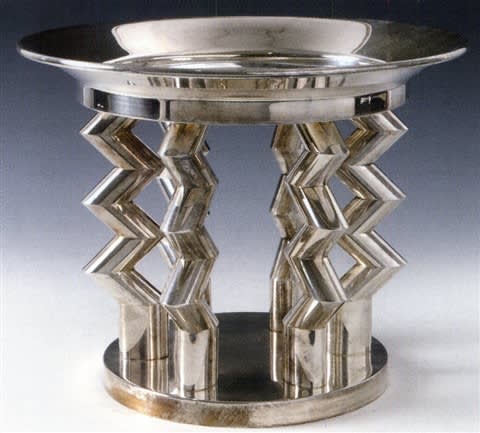
Ettore Sottsass
"Murmansk" Fruit Dish, 1982
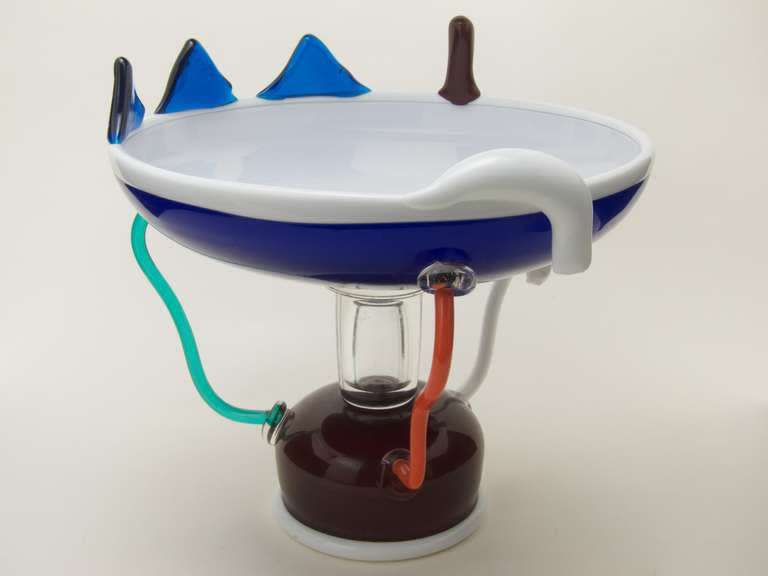
Ettore Sottsass
"SOL" Fruit Bowl, 1986
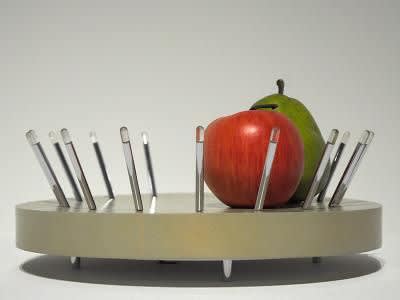
Shiro Kuramata
Fruit Bowl, 1988
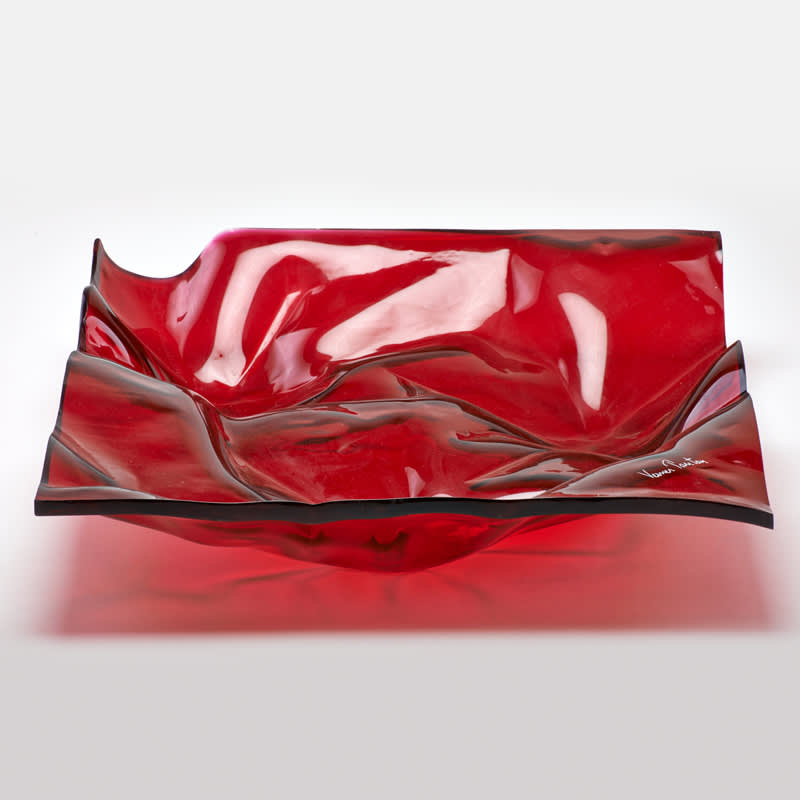
Verner Panton
Fruit Bowl, 1988
While Urs Fischer’s toilet-turned-fruit basket may not be the most conventional means of storing edible objects, a number of prominent architects and designers have created viable alternatives. The 1980s was an era of fruit bowl innovation. Throughout the decade, designers such as Shiro Kuramata, Ettore Sottsass and Verner Paton all crafted vessels for housing fruit, each design echoing their individualistic creative ethos and respective style.

The Big Pineapple
Bathurst, South Africa

Michael Graves
Clos Pegase Winery, 2007, Napa Valley, California

Michael Graves
Clos Pegase Winery, 2007, Napa Valley, California

Mario Botta
Petra Winery, 2003, Suvereto, Italy

Mario Botta
Petra Winery, 2003, Suvereto, Italy
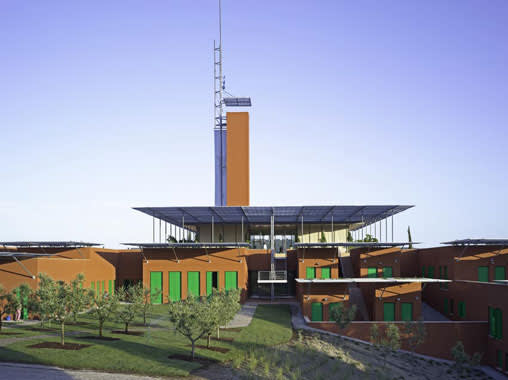
Renzo Piano
La Rocca Winery, 2007, Gavorrano, Italy

Renzo Piano
La Rocca Winery, 2007, Gavorrano, Italy
While Bathurst, South Africa is home to a pineapple farm on which a large-scale pineapple-shaped building sits, housing a museum devoted to the tropical fruit, a number of notable architects have permeated the grape-based wine industry through the design of structures on the grounds of prominent vineyards around the world. In 1986, acclaimed American architect Michael Graves completed the design of Clos Pegase Winery in Napa Valley, imbuing his post-modern aesthetic throughout the grounds of the vineyard’s palatial property. In 2003, Swiss architect Mario Botta was hired to design Petra Winery in Tuscany. Bota integrated his hallmark design attributes such as clean forms and geometric shapes within the landscape of the property, effortlessly imposing structures amidst rolling hills and lush surroundings. Similarly, Renzo Piano competed a Tuscan winery in 2007 that paid homage to traditional Tuscan wine making, with a majority of the vineyard’s operational elements taking place underground, and a simple, glass structure sitting atop.
The wine regions of Spain are home to some of the most remarkable vineyards in the world, which boast structures by Santiago Calatrava, Zaha Hadid and Frank Gehry. The Calatrava-designed Bodegas Ysios in Guardia, Spain, completed in 2001, combines concave and convex surfaces, generating a kinetic effect of static movement through the building’s fluid lines and the interaction between the structure’s materials and the sunlight. In 2006, Zaha Hadid completed a tasting pavilion for one of the Spain’s oldest wineries, in the region of La Rioja, while that same year, Frank Gehry designed a hotel on the grounds of Marques de Riscal Winery. The building’s exterior, covered in gigantic titanium panels tinted to mimic the colors of wine, imitates the fluid lines and hilly landscape of the vineyard’s surrounding environment.
From fruit bowls and vineyards, to banana bathing suits, grape-covered couture jackets, and still lifes by impressionist painters, sometimes a trip to the local supermarket or a visit to your at-home pantry is where the greatest inspiration lies.
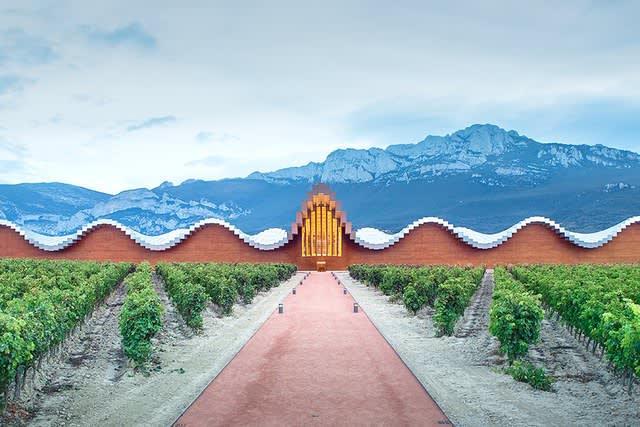
Santiago Calatrava
Bodegas Ysios, 2001, Guardia, Spain

Santiago Calatrava
Bodegas Ysios, 2001, Guardia, Spain
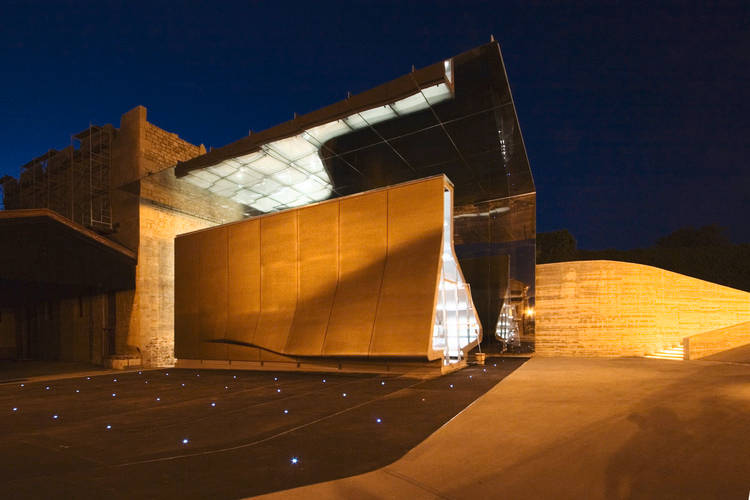
Zaha Hadid
Rafael López de Heredia Tondonia Winery, 2006, La Rioja, Spain
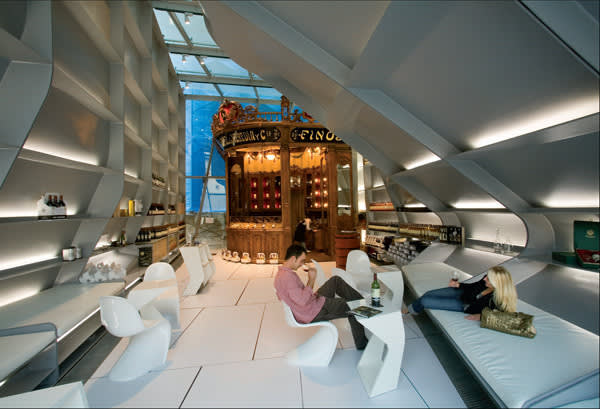
Zaha Hadid
Rafael López de Heredia Tondonia Winery, 2006, La Rioja, Spain
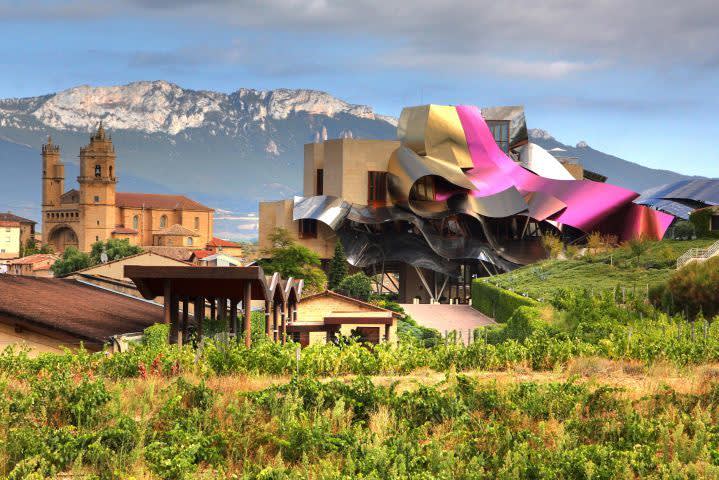
Frank Gehry
Hotel Marqués de Riscal, 2006, Elciego, Spain



